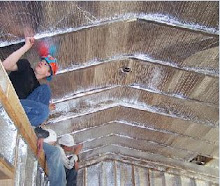 Radiant Barriers are materials that inhibit heat transfer by using thermal radiations. They are usually installed in homes and offices in order to reduce heat gain during summer and heat loss during winter. They are a great way to reduce the heating and cooling energy usage of your building as they help reduce the load on your air-conditioning system.
Radiant Barriers are materials that inhibit heat transfer by using thermal radiations. They are usually installed in homes and offices in order to reduce heat gain during summer and heat loss during winter. They are a great way to reduce the heating and cooling energy usage of your building as they help reduce the load on your air-conditioning system.Popular radiant barriers are built using a very thin sheet of aluminum which can either be applied to single or both sides of substrate materials. Instead of aluminum, coatings of other highly reflective materials are also used. Some variants are even reinforced using fiber as it helps from a durability perspective. Reflective material is used to build radiant barriers as it reflects heat rather than absorbing the heat. The substrates can be based on cardboard, plywood or craft paper.
For homes, these radiant barriers are most popularly used in attics because they reduce heat gains during summer and heat loss during winter. It is easy to install them for attics in your home. One of the easiest ways to install these is to place it on top of existing insulation. Make sure that the reflective side is facing up. An alternative mechanism of installation is to attach it in proximity to the roof. It can be attached directly to underside of roof or it can be draped on top of rafters before roof deck is applied. If it used on floor, it is a must that the radiant barrier allows water vapor to pass through it. If it does not do so, water vapor may condense and eventually freeze.
You can even install radiant barrier yourself. To do so, make sure that you read the precautions and detailed instructions provided by your vendor. However, it is advisable to hire a professional contractor or advisor in case you are planning to get it installed in a new building (home or office). Also keep in mind that the efficiency is highly dependent on a proper installation.
Radiant Barriers are most effective during summers and can be used in any type of buildings - homes, offices and industries. They can help reduce your cooling costs by as much as 20%.
For more information on this article, please visit http://www.coolattix.com or[http://www.greencollaroperations.com]attic insulation Austin.
Article Source: [http://EzineArticles.com/?What-is-a-Radiant-Barrier?&id=3978643] What is a Radiant Barrier?








